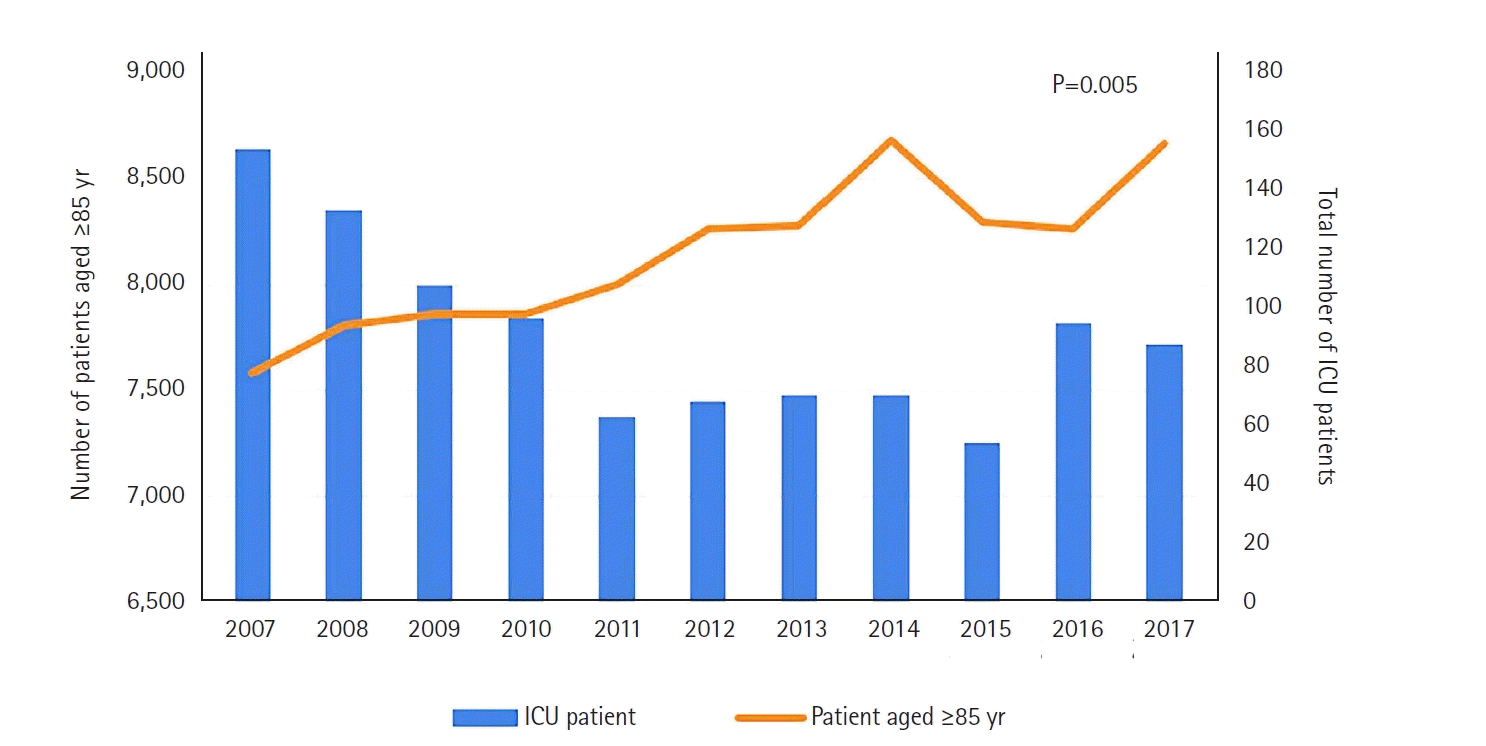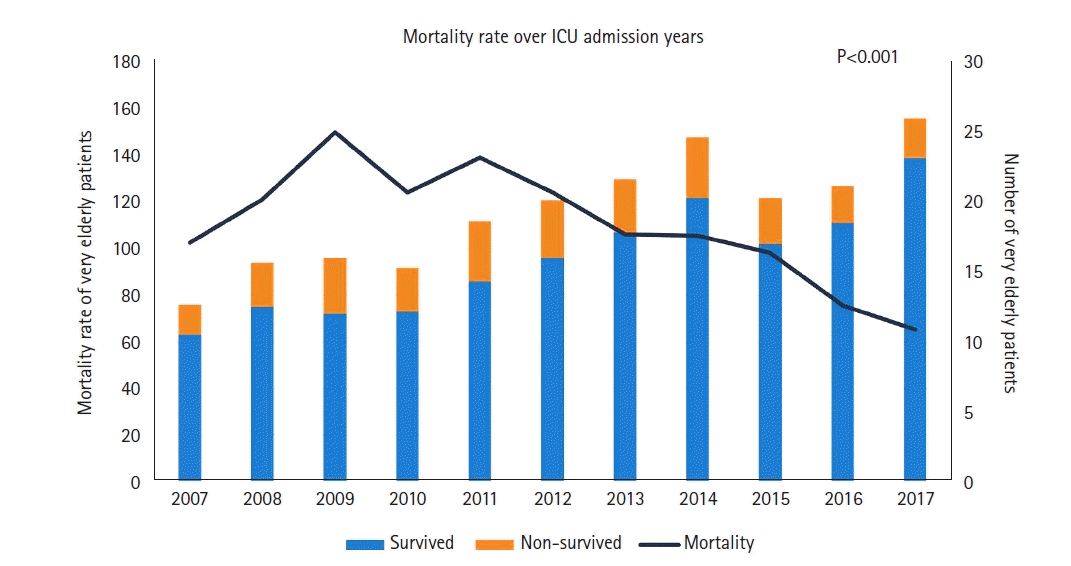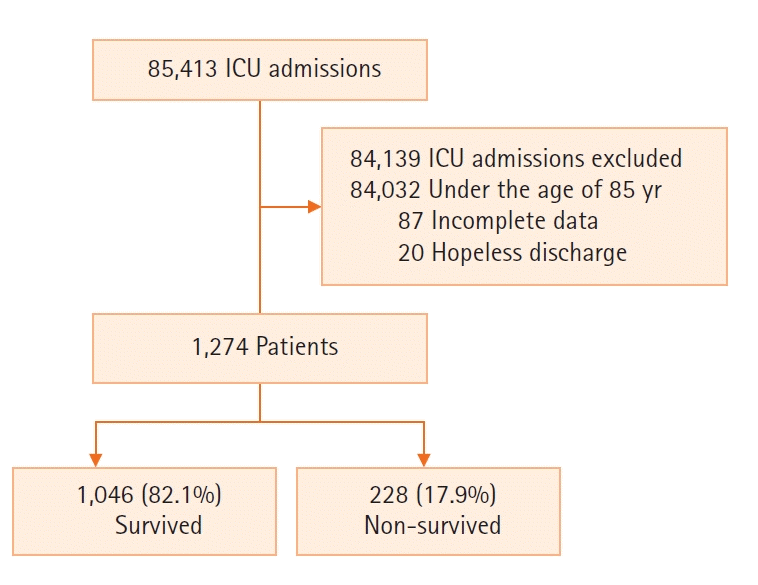INTRODUCTION
MATERIALS AND METHODS
Study Population and Study Design
Statistical Analysis
RESULTS
Patients’ Baseline Characteristics
Differences between the First Half (2007–2012) and the Second Half (2013–2017) of the Study Period
Figure 2.

Table 1.
| Characteristics | All patients | 2007–2012 | 2013–2017 | P-value |
|---|---|---|---|---|
| No. of patients | 1,274 | 591 | 683 | |
| Age (yr) | 87.8±2.9 | 87.7±2.8 | 87.9±3.0 | 0.243 |
| Men | 603 (47.3) | 292 (49.4) | 311 (45.5) | 0.167 |
| SOFA score | 14.2±4.4 | 14.5±4.5 | 13.9±4.4 | 0.033 |
| Reason for index ICU admission | ||||
| Medical | 916 (71.9) | 396 (67.0) | 520 (76.1) | <0.001 |
| Surgical | 358 (28.1) | 195 (33.0) | 163 (23.9) | <0.001 |
| Admission source | 0.041 | |||
| Ward | 298 (23.4) | 121 (20.5) | 177 (25.9) | |
| Emergency room | 945 (74.2) | 458 (77.5) | 487 (71.3) | |
| Others | 31 (2.4) | 12 (2.0) | 19 (2.8) | |
| Underlying disease | 1,028 (80.7) | 463 (78.3) | 565 (82.7) | 0.048 |
| Hypertension | 840 (65.9) | 373 (63.1) | 467 (68.4) | 0.048 |
| Chronic heart disease | 281 (22.1) | 102 (17.3) | 179 (26.2) | <0.001 |
| Hematologic malignancy | 3 (0.2) | 2 (0.3) | 1 (0.1) | 0.481 |
| Solid tumor | 63 (4.9) | 18 (3.0) | 45 (6.6) | 0.004 |
| Chronic liver disease | 10 (0.8) | 6 (1.0) | 4 (0.6) | 0.386 |
| Chronic lung disease | 81 (6.4) | 36 (6.1) | 45 (6.6) | 0.717 |
| DM | 336 (26.4) | 159 (26.9) | 177 (25.9) | 0.690 |
| CKD | 46 (3.6) | 17 (2.9) | 29 (4.2) | 0.191 |
| CVA | 147 (11.5) | 55 (9.3) | 92 (13.5) | 0.020 |
| Nonoperative admission diagnoses | ||||
| Cardiovascular | 357 (39.0) | 152 (38.4) | 205 (39.4) | 0.749 |
| Respiratory | 165 (18.0) | 82 (20.7) | 83 (16.0) | 0.064 |
| Gastrointestinal & hepatobiliary | 81 (8.8) | 39 (9.8) | 42 (8.1) | 0.350 |
| Nephrological | 16 (1.7) | 8 (2.0) | 8 (1.5) | 0.581 |
| Oncologic | 4 (0.4) | 3 (0.8) | 1 (0.2) | 0.199 |
| Infection | 13 (1.4) | 9 (2.3) | 4 (0.8) | 0.057 |
| Hematologic | 2 (0.2) | 2 (0.5) | 0 | 0.105 |
| Neurologic | 116 (12.7) | 45 (11.4) | 71 (13.7) | 0.302 |
| Othersa | 162 (17.7) | 56 (14.1) | 106 (20.4) | 0.014 |
| Operative admission diagnoses | ||||
| Cardiovascular | 89 (24.9) | 45 (23.1) | 44 (27.0) | 0.393 |
| Gastrointestinal & hepatobiliary | 109 (30.4) | 50 (25.6) | 59 (36.2) | 0.031 |
| Orthopedic | 65 (18.2) | 50 (25.6) | 15 (9.2) | <0.001 |
| Renal | 12 (3.4) | 5 (2.6) | 7 (4.3) | 0.365 |
| Neurosurgical | 50 (14.0) | 29 (14.9) | 21 (12.9) | 0.589 |
| Respiratory | 15 (4.2) | 9 (4.6) | 6 (3.7) | 0.660 |
| Gynecologic | 2 (0.6) | 0 | 2 (1.2) | 0.121 |
| Othersb | 16 (4.5) | 7 (3.6) | 9 (5.5) | 0.378 |
Figure 3.

Table 2.
| Characteristics | All patients | 2007–2012 | 2013–2017 | P-value |
|---|---|---|---|---|
| Support during index ICU stay | ||||
| Mechanical ventilation | 432 (33.9) | 205 (34.7) | 227 (33.2) | 0.585 |
| Ventilator weaning (n=432) | 273 (63.2) | 120 (58.5) | 153 (67.4) | 0.056 |
| Noninvasive ventilation | 15 (1.2) | 4 (0.7) | 11 (1.6) | 0.123 |
| Vasopressor | 414 (32.5) | 174 (29.4) | 240 (35.1) | 0.030 |
| Renal replacement therapy | 99 (7.8) | 50 (8.5) | 49 (7.2) | 0.393 |
| CAG | 59 (4.6) | 32 (5.4) | 27 (4.0) | 0.216 |
| Outcome | ||||
| ICU mortalitya | 163 (12.8) | 86 (14.6) | 77 (11.3) | 0.076 |
| 28-day ICU mortality | 145 (11.4) | 77 (13.0) | 68 (10.0) | 0.071 |
| In-hospital mortalitya | 228 (17.9) | 126 (21.3) | 102 (14.9) | 0.001 |
| ICU LOS | 3.0 (1.0–6.0) | 3.0 (1.0–7.0) | 2.0 (1.0–6.0) | 0.283 |
| Hospital LOS | 12.0 (6.0–24.0) | 13.0 (6.0–28.0) | 11.0 (5.0–22.0) | 0.041 |
Values are presented as number (%) or median (interquartile range).
ICU: intensive care unit; CAG: coronary angiography; LOS: length of stay.
a Statistics were performed by correcting for the Sequential Organ Failure Assessment score, reason for admission to ICU, hypertension, chronic heart disease, solid tumor, and cerebrovascular accident among the underlying diseases, which had a P<0.1 difference in the patient's underlying characteristics.




 PDF
PDF Citation
Citation Print
Print




 XML Download
XML Download